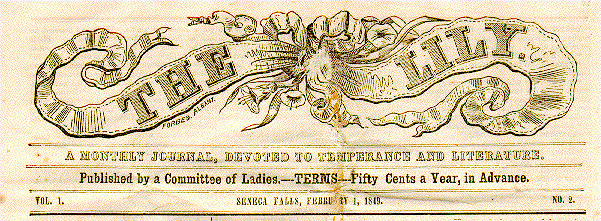Amelia Jenks Bloomer: The Pioneer of the First Newspaper, Made for Women
March 23, 2023
On May 27, 1818, Amelia Bloomer was born. The world wouldn’t know it yet, but Amelia Bloomer would go on to be an advocate for temperance and women’s rights, an icon for an unusual women’s fashion trend, and the first woman to create a newspaper for women.
Born in Homer, New York, Amelia Jenks was raised by a middle-class family, with at least six other siblings. She would grow up only getting a few years of professional education, teachers and students have said that she was highly intelligent. Women at the time were to be considered housewives and stay-at-home moms, doing all of the housework. Education for women consisted of languages like Greek and Latin, classes teaching social and ladylike etiquette, making women become”marriageable beings” (um… ew). Despite all of this, Bloomer became a public school teacher, and later a private tutor.
In 1840 at the age of 22, Amelia married Dexter Bloomer, an attorney, becoming Amelia Jenks Bloomer (known to most, as Amelia Bloomer). She and her husband moved to Seneca Falls, New York, where they would live there for thirteen years. While residing in Seneca Falls, Amelia quickly became involved in the politics and the society of the community. She would also help edit her husband’s newspaper, the Seneca Falls County Courier. Dexter said that Amelia could use this as an outlet for her writing. In the following years, Amelia would write columns in favor of temperance and women’s rights. This would lead her to join temperance movements in the area where she lived.
Then, in 1848, Amelia Bloomer attended the first Women’s Rights Convention of Seneca Falls, organized by Elizabeth Cady Stanton, who also lived in Seneca Falls, joining three hundred other attendees. Other suffragists like Lucretia Mott and Frederick Douglass showed up too.
“We hold these truths to be self-evident; that all men and women are created equal.” – Declaration of Sentiments, Seneca Falls Convention
Seven months later on January 1st of 1949, Amelia Bloomer made history. Encouraged by women by the likes of Susan B. Anthony, and Stanton, Amelia Bloomer edited and published the first-ever newspaper made for women, titled The Lily. The Lily‘s main topic was temperance, but with the help of Stanton, that changed. The newspaper wrote on a broad spectrum, including topics like recipes, social reforms, higher education for women, and suffrage, just to name a few. The groundbreaking newspaper first was published every month. In the image above, the issue was published on February 1st, 1849, making it the second publishing of The Lily.
Then in 1851, came a dress reform.
Women’s fashion at the time was highly restrictive. The Smithsonian Magazine informs “The dictates of modesty called for floor-length dresses, and fashion demanded a full skirt beneath a tiny waist. As a result, middle- and upper-class American women squeezed themselves into corsets and six to eight petticoats to fill out the shape of their skirts. The result weighed up to 15 pounds, placed enormous pressure on their hips, and made movement a struggle.” So in other words, imagine a bowling ball placed on your hips. Women at the time couldn’t possibly deal with all of that; on top of their social reforms. Thus, a trend of wearing pants began. Though Amelia didn’t invent this idea, she gave it a name. The “Bloomer” look consisted of pantaloons (baggy pants) paired with a skirt just below the knee. Amelia believed that “the costume of women should be suited to her wants and necessities.” Suffragists like Susan B. Anthony, Lucy Stone, and Elizabeth Cady Stanton sported the look too. A name was also given to women who supported this trend, they became known as “Bloomers.”
The fashion still applied to the proper dress code (women’s bodies were covered from the neck to their feet), but Bloomers sparked backlash from anti-suffragists, so bad that Amelia Bloomer herself stopped wearing her fashion. Bloomers wanted social reforms for women’s rights, so they thought that an immense amount of backlash wouldn’t help their problem.
The Lily kept writing, editing, and publishing papers, now bi-weekly, even though the Bloomer family moved This continued until 1854, when Amelia and her husband decided to move to Council Bluffs in Iowa. In Council Bluffs, there were no places where you could publish a newspaper. Thus, she sold The Lily. The newspaper was handed over to a woman named Mary Birdsall. But, all good things come to an end; so on December 15th, 1856, The Lily published its final issue.
Amelia Bloomer took her leaving the newspaper as an act of love. In her adieu, she wrote, “But The Lily, being as we conceive of secondary importance, must not stand in the way of what we believe our interest.”
Throughout the rest of her life, Amelia Bloomer was still a pioneer for the Women’s Movement. She also continued to write and lead suffrage campaigns. Between the years 1871-1873, Bloomer was the president of the Iowa Woman Suffrage Association. She died in 1894 at the age of 76.
Today, she is an unsung hero of the Women’s Suffrage Movement. Shortly after her death, her husband, Dexter Bloomer, honored her work, publishing Life and Writings of Amelia Bloomer. Although Bloomer’s works aren’t as well-known as some of her other suffragists, her works helo lead to political rights, educational benefits, and employment opportunities for women during the 19th century. Although many people don’t know her name, Amelia Bloomer was influential and changed society for women today.
“It is woman that speaks through The Lily…Intemperance is the great foe to her peace and happiness…Surely, she has the right to wield her pen for its Suppression. Surely, she may without throwing aside the modest refinements which so much become her sex, use her influence to lead her fellow mortals from the destroyer’s path.” – Amelia Bloomer, the first issue of The Lily



